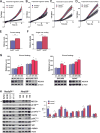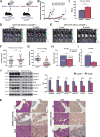NEDD9 promotes oncogenic signaling, a stem/mesenchymal gene signature, and aggressive ovarian cancer growth in mice
- PMID: 29773902
- PMCID: PMC6119087
- DOI: 10.1038/s41388-018-0296-y
NEDD9 promotes oncogenic signaling, a stem/mesenchymal gene signature, and aggressive ovarian cancer growth in mice
Abstract
Neural precursor cell expressed, developmentally downregulated 9 (NEDD9) supports oncogenic signaling in a number of solid and hematologic tumors. Little is known about the role of NEDD9 in ovarian carcinoma (OC), but available data suggest elevated mRNA and protein expression in advanced stage high-grade cancers. We used a transgenic MISIIR-TAg mouse OC model combined with genetic ablation of Nedd9 to investigate its action in the development and progression of OC. A Nedd9-/- genotype delayed tumor growth rate, reduced incidence of ascites, and reduced expression and activation of signaling proteins including SRC, STAT3, E-cadherin, and AURKA. Cell lines established from MISIIR-TAg;Nedd9-/- and MISIIR-TAg;Nedd9+/+ mice exhibited altered migration and invasion. Growth of these cells in a syngeneic allograft model indicated that systemic Nedd9 loss in the microenvironment had little impact on tumor allograft growth, but in a Nedd9 wild-type background Nedd9-/- allografts exhibited significantly reduced growth, dissemination, and oncogenic signaling compared to Nedd9+/+ allografts. Gene expression analysis revealed that Nedd9+/+ tumors exhibited more mesenchymal "stem-like" transcriptional program, including increased expression of Aldh1a1 and Aldh1a2. Conversely, loss of Nedd9 resulted in increased expression of differentiation genes, including fallopian tube markers Foxj1, Ovgp1, and Pax8. Collectively, these data suggest that tumor cell-intrinsic Nedd9 expression promotes OC development and progression by broad induction of oncogenic protein signaling and stem/mesenchymal gene expression.
Conflict of interest statement
Figures






Similar articles
-
NEDD9 promotes lung cancer metastasis through epithelial-mesenchymal transition.Int J Cancer. 2014 May 15;134(10):2294-304. doi: 10.1002/ijc.28568. Epub 2013 Nov 15. Int J Cancer. 2014. PMID: 24174333
-
NEDD9 is a positive regulator of epithelial-mesenchymal transition and promotes invasion in aggressive breast cancer.PLoS One. 2011;6(7):e22666. doi: 10.1371/journal.pone.0022666. Epub 2011 Jul 28. PLoS One. 2011. PMID: 21829474 Free PMC article.
-
Withaferin-A induced vimentin S56 phosphorylation dissociates NEDD9 signaling loop to regress progressive metastatic melanoma into lung adenocarcinoma.Chem Biol Interact. 2025 Jan 25;406:111319. doi: 10.1016/j.cbi.2024.111319. Epub 2024 Nov 27. Chem Biol Interact. 2025. PMID: 39613173
-
Roles of neural precursor cell expressed, developmentally downregulated 9 in tumor-associated cellular processes (Review).Mol Med Rep. 2015 Nov;12(5):6415-21. doi: 10.3892/mmr.2015.4240. Epub 2015 Aug 24. Mol Med Rep. 2015. PMID: 26324022 Review.
-
Preclinical and clinical studies of the NEDD9 scaffold protein in cancer and other diseases.Gene. 2015 Aug 1;567(1):1-11. doi: 10.1016/j.gene.2015.04.086. Epub 2015 May 9. Gene. 2015. PMID: 25967390 Free PMC article. Review.
Cited by
-
NEDD9 links anaplastic thyroid cancer stemness to chromosomal instability through integrated centrosome asymmetry and DNA sensing regulation.Oncogene. 2022 May;41(21):2984-2999. doi: 10.1038/s41388-022-02317-7. Epub 2022 Apr 22. Oncogene. 2022. PMID: 35449243
-
Transcription factor 7 like 2 promotes metastasis in hepatocellular carcinoma via NEDD9-mediated activation of AKT/mTOR signaling pathway.Mol Med. 2024 Jul 25;30(1):108. doi: 10.1186/s10020-024-00878-9. Mol Med. 2024. PMID: 39060928 Free PMC article.
-
Arginine Methyltransferase PRMT7 Deregulates Expression of RUNX1 Target Genes in T-Cell Acute Lymphoblastic Leukemia.Cancers (Basel). 2022 Apr 26;14(9):2169. doi: 10.3390/cancers14092169. Cancers (Basel). 2022. PMID: 35565298 Free PMC article.
-
NEDD9 Overexpression Causes Hyperproliferation of Luminal Cells and Cooperates with HER2 Oncogene in Tumor Initiation: A Novel Prognostic Marker in Breast Cancer.Cancers (Basel). 2023 Feb 9;15(4):1119. doi: 10.3390/cancers15041119. Cancers (Basel). 2023. PMID: 36831460 Free PMC article.
-
The Prognostic Significance of NEDD9 Expression in Human Cancers: A Systematic Review, Meta-Analysis, and Omics Exploration.Technol Cancer Res Treat. 2024 Jan-Dec;23:15330338241297597. doi: 10.1177/15330338241297597. Technol Cancer Res Treat. 2024. PMID: 39540210 Free PMC article.
References
-
- Siegel RL, Miller KD, Jemal A. Cancer statistics, 2016. CA: A Cancer Journal for Clinicians. 2016;66(1):7–30. - PubMed
-
- McPherson A, Roth A, Laks E, Masud T, Bashashati A, Zhang AW, et al. Divergent modes of clonal spread and intraperitoneal mixing in high-grade serous ovarian cancer. Nat Genet. 2016;48(7):758–67. - PubMed
Publication types
MeSH terms
Substances
Grants and funding
LinkOut - more resources
Full Text Sources
Other Literature Sources
Medical
Molecular Biology Databases
Miscellaneous

